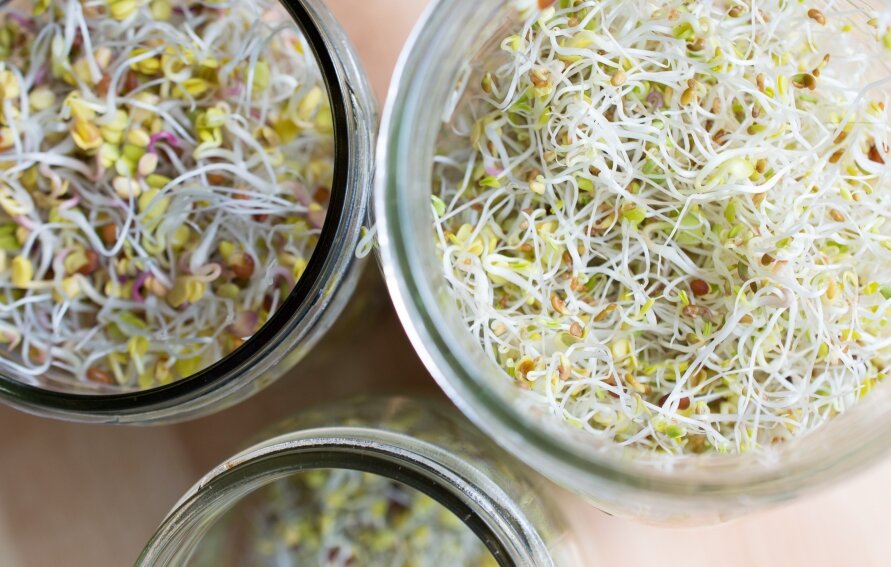Microgreens
There’s a lot of buzz around microgreens in the functional foods world today. Here’s everything you need to know about this latest craze.
What are microgreens
Microgreens are baby vegetables and just a phase of the plant’s life.
Here are the different plant phases:
Phase 1 - Sprouts (2-5 days old)
Phase 2 - Microgreens (10-14 days old)
Phase 3 - Baby greens (15-40 days old)
Phase 4 - the mature plant (40-150 days old)
To understand microgreens, it’s helpful to first understand sprouts.
Simply put, both sprouts and microgreens are baby plants. However, they differ in the way they’re grown, the way they taste, and in their nutritional content.
Sprouts are the first phase of the plant's life cycle and are barely germinated seeds that have grown in water for 2-5 days. They are usually only a couple inches long, don’t yet have real leaves, and you can eat the entire sprout from seed to root to stem. They’re typically pale in color and have not gone through photosynthesis meaning they have no green chlorophyll.
Microgreens are the 2nd phase in the plant's life cycle and 10-14 days old. The plant never has more key nutrients, minerals, vitamins, and antioxidants than around the 14-day mark in the microgreen phase! All plants go through this phase, but the most popular microgreens are broccoli, kale, radish, pea shoots, and sunflower.
Microgreens are usually 4-5 inches long and can be grown in soil or a substrate like jute or coconut fiber. At this point of harvest, they have real leaves, stems, and roots. To harvest them, you simply cut them off about one inch above the roots and eat them raw.
Because microgreens are so beautiful and add a pop of fresh flavor, they primarily exist as garnishes at high-end restaurants. However, over the past few years, researchers and health-food advocates have noticed their tremendous health benefits and started sneaking them into everyday meals from smoothies and sandwiches to salads and more.
You can learn more about the difference between sprouts and microgreens here.
Benefits of microgreens
Not only are microgreens pretty garnishes, they also provide tons of health benefits. Among these benefits are up to 40 times more nutritional content than their adult counterparts. Like vitamins, minerals, enzymes, antioxidants, and unique medicinal compounds.
Vitamin K1 is higher in amaranth, basil, and red cabbage microgreens than in their fully grown equivalents. Vitamin C concentration is 6 times higher in red cabbage microgreens than in adult red cabbage. In addition, lettuce microgreens showed higher concentrations of elements Calcium, Magnesium, Iron, Manganese, Zinc, Selenium, and Molybdenum than their adult counterparts.
Microgreens from cruciferous vegetables like Brussels sprouts and broccoli also have a unique compound called sulforaphane. Sulforaphane is a biologically active compound found in plants that can help manage viral load and glucose levels, protect your skin, improve brain function, and fight inflammation. It has also been shown to cause tumor cell death.
Sulforaphane is a potent and bioavailable activator of Nrf2. Nrf2s are important because they make antioxidants, which help the body fight inflammation and cell damage. Activating the Nrf2 pathway can help reduce systemic inflammation or inflammation all over the body.
Types of microgreens
There are tons of different types of microgreens. Any type of herb or salad green and many types of vegetables, like cruciferous vegetables, can be grown as microgreens.
Popular types of microgreens include:
Radish
Beet
Pea Shoots
Sunflower
Mustard
Amaranth
Basil
Kale
The most popular is Broccoli Microgreens
Broccoli Microgreens
Don’t like the taste of broccoli and want all the benefits? Then this microgreen is for you.
At this phase of the broccoli's life, it’s so sweet and light tasting that kids love to eat them.
Broccoli Microgreens are gaining tremendous popularity today because of the vast amount of research done on the benefits they provide. They can contain up to 40 times the levels of nutrients by weight compared to adult broccoli.
The most unique benefit is the production of sulforaphane, a naturally occurring compound and nature's most potent activator of the Nrf2 pathway. Nrf2 activates a biological process that helps the body to create its own antioxidants.
Here’s more on the 6 amazing health benefits of broccoli microgreens.
Where to buy microgreens
Support local growers at your farmer’s market.
Joining a local Community Supported Agriculture (CSA). This has become a popular way for consumers to buy local, seasonal food directly from a farmer. You will receive weekly-monthly deliveries.
Grow them yourself at home - Learn how here.
Buy shelf-stable online - Don’t worry about cooking, preparation or spoilage.
As far as functional foods go, microgreens are a quick and easy way to sneak more vegetables into your diet, year-round.
Share in the comments your favorite microgreens and ask us any questions.




